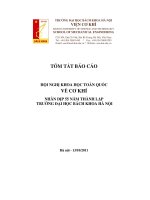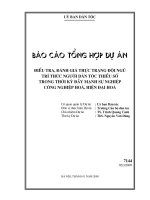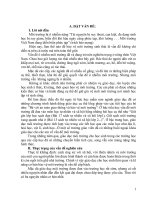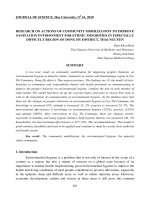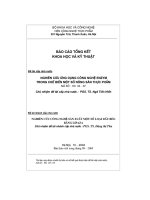Báo cáo nghiên cứu khoa học: "Nghiên cứu về hành động của vận động cộng đồng để cải thiện vệ sinh môi trường cho các dân tộc thiểu số trong khu vực đặc biệt khó khăn của huyện Đồng Hỷ, Thái Nguyên" docx
Bạn đang xem bản rút gọn của tài liệu. Xem và tải ngay bản đầy đủ của tài liệu tại đây (90.3 KB, 13 trang )
201
JOURNAL OF SCIENCE, Hue University, N
0
61, 2010
RESEARCH ON ACTIONS OF COMMUNITY MOBILIZATION TO IMPROVE
SANITATION ENVIRONMENT FOR ETHNIC MINORITIES IN ESPECIALLY
DIFFICULT REGION OF DONG HY DISTRICT, THAI NGUYEN
Dam Khai Hoan
Thai Nguyen University of Medicine and Pharmacy
Hoang Anh Tuan
Thai Nguyen Medical College
SUMMARY
A two year- study on community mobilization for improving people’s behavior on
environmental hygiene in minority ethnic community at remote and disadvantage region in Cay
Thi Commune, Dong Hy district, Thai nguyen province. The findings are (1) the model of inter-
branches in community and responsibility shared with health personnel in communicating to
improve the people’s behavior on environmental hygiene, combine the task of each member of
stake holder. The model had been set up the concrete duties and tasks to ensure their task as
well as the integration of communication of environmental hygiene, (2) the findings show that
there are the changes in people’s behavior on environmental hygiene in Cay Thi Commune, the
knowledge is increased 63%, attitude is increased 33, 2%, practice is increased 14, 5%. The
interventional effectiveness is knowledge on environmental hygiene (323%), practice (253%)
and attitude (206%). After intervention in Cay Thi Commune, there are changes clearly,
especially in building and using hygiene latrines, built hygiene latrines are increased (26, 5%
households), the interventional effectiveness is 217, 22%. The recommendations: This model is
good solution, feasibility and need to be applied and continue to study by certain local authority
and health system.
Key words: The community mobilization; the environmental hygiene; the minority
ethnic community.
1. Introduction
Environmental hygiene is a problem that is not only of interest in the scope of a
country or a region, but also a matter of concern on a global scale because of its
importance to human health. Implementing good environmental hygiene to improve the
health and living conditions of rural people contributes to poverty alleviation, especially
in the uplands, deep and difficult areas as well as ethnic minority areas. However,
economic development, culture and society in these areas is still poor, the common
202
people's living standards are low, their educational level has not improved,
transportation is difficult, and health care conditions and social welfare are still lacking.
In Dong Hy district, Thai Nguyen province, the behavior of environmental hygiene is a
problem. Therefore, we deem it necessary to improve environmental sanitation.
Mobilizing the community to participate in improving the behavior of environmental
hygiene is considered a good approach for solving these problems. Thus this research is
conducted to describe the actual situation of environmental hygiene behavior of ethnic
minorities in particularly difficult communes of Dong Hy district, Thai Nguyen
province, to build a model of community mobilization to improve environmental
hygiene behavior for people in Cay Thi commune, Dong Hy district, Thai Nguyen
province and to assess the effectiveness of the model for improving sanitation behavior
for ethnic minorities in Cay Thi commune after two years of implementation.
2. Methods
2.1. Subjects: All households, government leaders, government departments,
unions and medical workers.
2.2. Location: 4 communes (Cay Thi, Hop Tien, Van Lang and Tan Long) of
Dong Hy district, which are mountainous communes, in which Cay Thi is a intervention
commune and Hop Tien is a control commune
2.3. Time: From January 2006 to December 2007
2.4. Methods: A cross-sectional method was used to describe the actual situation
of environmental hygiene behavior and find the factors related to environmental
hygiene behavior. An Epidemiological intervention to build models to improve
sanitation behavior was also conducted.
2.4.1. Descriptive study Design: The combination of the properties. The sample
size was calculated for a cross-sectional survey of 800 but the actual survey sample was
830. Four communes of Dong Hy district were chosen intentionally, because they are
considered extremely difficult communes in Dong Hy. 200 households of ethnic
minorities in remote areas (the town center from 5 km) were selected from each
commune. Each household randomly selected one adult representative (as family
leader) from the list of households.
2.4.2. Intervention study design: The following interventions are confronting
the sample size was calculated based on a formula of epidemiological intervention n =
194, so the number of households in each commune was 200. We decided to choose Cay
Thi commune and Hop Tien commune because they have similar social characteristics.
2.4.3. The research indicators: Using Knowledge, Attitudes and Practice, (KAP)
on environmental sanitation as indicators. The KAP level distributed into three types of
variables, such as knowledge (K), attitude (A) and practice (P) for each problem will be
203
studied. The total of points for each variable was 10 points. The classification of KAP
levels are as follows: Total points from 10-70 points: Good; from 5 to 6 points:
average; <5 points : weak
2.4.4. Build models of intervention.
- Establish a Steering Committee to adopt the model in Cay Thi (intervention
commune)
- Train participants in basic issues of hygiene and environmental media and
methods of operation in the model (duration of the training course is one week).
- Assign functions and specific tasks to the participants
- The Steering Committee meets monthly to review the implementation
progress of the model and supplement and update the knowledge of some of its
members
- Activities of the team: Conduct a surveillance to review progress on
implementating models and to detect additional problems which require direct support
every two months.
- The activities of the model are continuous for about two years.
2.4.5. Information gathering techniques
* Quantity: Interview households: investigators conducted interviews directly to
householders. Interviews were recorded on pre-printed forms which were designed in
accordance with the procedures and requirements of the research. These forms were
pre-tested at Cay Thi commune, then revised again before printing. Observations in
homes and information collected from health centre reports.
* Identification: Focus group discussions were used to explore cultural aspects,
hygiene habits of the people and the acceptability of the community model: There were
two discussion groups (one before and the one following the intervention) with the
steering committee members and community representatives (approximately 10 people
for each).
2.4.6. Assessment methods. Comparisons of KAP about environmental sanitation
change in Cay Thi and Hop Tien before and after intervention. Results were ranked
based on intervention effectiveness index and effective interventions.
2.4.7. Method of processing data. The software EPIINFO 6:04 was used.
3. Results
3.1. Knowledge attitude practice (KAP) about environmental sanitation of
people in the researched communes
204
Table 3.1. KAP of the people who undertook water and management of water distribution.
KAP n %
Source water agreements: good knowledge 249 30.
Behaviour 176 21.20
Good Practice 134 16.14
Distribution management: good knowledge 168 20.24
Behaviour 159 19.16
Good Practice 89 10.72
The results revealed the KAP of people concerning water is very low: The
percentage of people with good knowledge only reached 30%, good attitudes and good
practices account for only 21.2% and 16.14 %. Concerning water management, the
percentage of people who had good knowledge of management was 20.24%, the
percentage of good attitudes and good practice was also lower: 19.16% and 10.72%
respectively
In the community, before our intervention was implemented a panel discussion
with local leaders and residents of Cay Thi was conducted. When discussing water
issues, according to Mr. K - Farmer's Market "local water sources are mainly used, as
dug wells, which are not sanitary, the cause of pollution is caused by grazing and
deforestation at the watershed "Mr. X - President of the National Social Front, said:"
As neighbors get water vascular plants from the mountain town to households and three
neighbors used deep troughs using water from streams to their homes The cause of
water pollution was due to mining, a few households also raise stock, sanitation as
water wells near food. There are not hygienic latrines by customs still optimistic Miss.
When discussing the management of water sources, Mr. C – Cay Thi commune
said "Look at the toilet hygiene of the households in eight neighborhoods, I found most
of the households have sanitary latrines ". Mr. H – from the commune health center
said: " There are no hygienic latrines in four remote hamlets of Cay Thi, this is caused
by backward habits of sanitation. The solution for this is to communicate in order to
change people's behavior ". In summary, water sanitation in the communes is not good,
polluted by negative behaviors of people like the indiscriminate exploitation of mineral,
water near the latrines, cattle pens People also use the slots, spring water and
largely indiscriminate release UE is common due to no hygiene toilet
Table 3.2. KAP of the people who had cattle pens and chemical plant protection
KAP n %
Animal cages: good knowledge 289 34.82
205
Behaviour 249 30.
Good Practice 176 21.20
Chemical plant protection: good
knowledge
166 20.
Behaviour 158 19.04
Good Practice 89 10.72
In the KAP Synthesis of people on blankets, drop, construction of animal barns
we saw that: good knowledge of the people on these issues is still low, reaching only
34.82%. The scores of attitudes, and practice of the people was also low, only 30% and
21.2%. Knowledge, attitudes and practices of the population with chemical plant
protection is not yet possible. In our study, the proportion of people with good
knowledge of 20%, good attitudes and good practices as 19.04% and 10.72%
respectively
According to Ms. M – Cay Thi primary school: "The farm animals and do not
just drop hygienic ". According to Mr. K - Commune Farmer Association: "The
raising of cattle and cattle ranching also no longer present if the neighbors are mostly in
remote areas. The rate of latrine use is low due to the habits and practices "
Table 3.3. KAP of the people about sanitation
KAP n %
Good knowledge 179 21.57
Behaviour 157 18.92
Good Practice 79 9.52
General knowledge of environmental sanitation of the people is at a very low
level, at 21.57%. The results of good behavior and good practice on environmental
hygiene is also very low (18.93% and 9.52% respectively).
When discussing sanitation issues in general, according to Mr. T – Cay Thi
People’s Community: "Now latrines and hygiene of the households in the most remote
hamlets are a problem. The reason is their habits. The knowledge people have about
hygiene is very limited. Particularly in three remove hamlets people still feed free pigs
" So the proportion of households who have clean water, sanitary latrines, and
bathrooms are very low. The leading cause is due to the customs and obsolete traditions,
and poverty communication on sanitation is necessary. The party, government,
departments should motivate the active participation on the medical basis to ensure the
success
206
3.2. Building a model of intervention
3.2.1. The results of model intervention. The model was built with the
participation of key community organizations. Members of the model were assigned
proper tasks
3.2.2. Operation results of the model:
* Results of model training
Table 3.4. Results of model training
Time
Level
Pretest Postest
p
n % n %
Pretty, Good 14 33.33 28 66.66
<0.05
Average 15 35.71 12 28.57
Weak 13 30.95 2 9.52
Total 42 42
After training, the participant's knowledge about environmental sanitation
increased markedly, to an especially good level (p <0.05).
* Implementation: The model has been in operation since September 2006. The
content and implementation plan are designed as a specific model. On the basis of
assigned duties, the commune health center staff supervised professional activities. The
Commune People’s Committee had a resolution on the implementation of sanitation
projects for the implementation of each Party member. CPC documents guided the
implementation of the sanitation department and send it to the village chief. The
departments have guidelines made by members. The implementation of the sanitation
standard promoted an emulation among party members, union members, many
members of mass organizations Every week, the health volunteers, the collaborators
and nutritionists, with the support of village leaders, youth in the village have taken to
visit households and combine health education. On the last day of each month, members
send reports to the leader of commune health centers (CHC). He reviewed and provided
information to the members what has been done, and what should be added to next
month for better performance
* Supervision: The right process, the team will supervise and inspect the actual
activities of the village members. The supervisors consider the reports of health
volunteers, collaborators and teachers, reviews of economic growth while listening to
the leader of CHC reflects the opinions of people in the original. Every two months, the
team meets the CPC and the leader of CHC to evaluate the activities of members in
villages and discuss additional issues that need more direct support. The leader of the
207
CHC supervises the health volunteers and collaborators’ daily work in the medical
professional field.
* Results of communication activities
Table 3.5. The results of specific activities of the participants concerning the model indicators
Indicators
Member
Number of
sessions
transmitted
through
meetings
Number of
communicati
on sessions in
households
Number of
listeners
Commune health station staff 10 105 198
Village health workers 51 423 982
Women 8 120 379
Youth Union 42 387 1.235
Farmer 8 45 125
Teachers 'plug' 13 78 234
University medical student 24 490 678
The other mass organizations 12 24 132
Total 168 1.672 3.963
The above results show the organizations involved in communication on
sanitation works. the leading groups are health staff, medical students, youth union and
teachers are plugging the organizations most active.
3.3. Effective models of intervention in changing people's environmental
sanitation behavior Cay Thi and Hop Tien, Dong Hy district, Thai Nguyen province
Table 3.6. Change KAP on environmental sanitation of the people to conform to social
Time
hygiene
environment
Before
intervention
After
intervention
Difference
(%)
performance
indicators
(%)
p
n % n %
Good knowledge 39 19.5 165 82.5 63. 323. p<0.05
Behaviour 32 16. 98 49. 33.2 206. p<0.05
Good Practice 19 9.5 67 33.5 14.5 253. p<0.05
208
After the intervention the change in people's KAP on environmental sanitation is
illustrated in table 3.6. Clearly the most effective interventions are knowledge of
sanitation (323%), followed by sanitation practices (253%) and attitudes (206%) with p
<0.05.
Table 3.7. Behavior change using the people's communes CTVS Tree Market
Time
hygienic
work
Before
intervention
After
intervention
Difference
(%)
performance
indicators
(%)
p
n % N %
Clean Water 95 47.5 115 57.5 10 20 >0.05
Sanitary latrines 21 10.5 74 37.0 26.5 252 <0.05
Bathroom 90 45. 128 64.0 19 42 >0.05
Move animal
cages away from
housing
35 17.5 45 22.5 5 29 >0.05
After intervention in Cay Thi, there was a significant change in building and
using sanitary latrines, effective intervention is 252% (p <0.05), but other issues had
low efficiency and are not statistically significant (p> 0.05).
Table 3.8. Change KAP on environmental sanitation of Hop Tien commune
Time
hygienic
work
Before
intervention
After
intervention
Difference
(%)
performance
indicators
(%)
p
n % N %
Good knowledge 32 16 76 38 22 138 p<0.5
Behaviour 30 15 40 20 5 33 p>0.5
Good Practice 20 10 30 15 5 50 p>0.05
After nearly two years in Hop Tien commune without intervention, there was the
significant change in people's knowledge of environmental hygiene, with the index
reaching 138% of efficiency (p <0.05). Other issues have also changed and are at less
effective (p> 0.05).
209
Table 3.9. Change of use CTVS of Hop Tien commune
Time
hygienic
work
Before
intervention
After
intervention
Differenc
e
(%)
performanc
e indicators
(%)
p
n % N %
Clean Water 83 41.5 98 49.0 7.5 18.07 >0.05
Sanitary latrines 23 11.5 31 15.5 4 34.78 >0.05
Bathroom 95 47.5 113 56.5 9 18.95 >0.05
Move animal
cages away from
housing
39 19.5 47 23.5 4 20.51 >0.05
After nearly two years, Hop Tien commune had no significant change in the use
of latrines. The percentage of CTVS in Hop Tien increased but this is small and had low
efficiency (p> 0.05).
Table 3.10. KAP on environmental sanitation after intervention
Time
Hygienic
Work
Cây Thị
(n.200)
Hợp Tiến (n.200)
Difference
(%)
work
efficiency
p
n % n %
Good
knowledge
165 82.5 76 38 44.5 185 p<0.05
Behaviour 98 49 40 20 29 176 p<0.05
Good Practice 67 33.5 30 15 18.5 133 p<0.05
After intervention there was a dramatic change in KAP. The KAP of the people
in Cay Thi is significantly higher in number of effective and efficient sanitation
interventions than Hop Tien. The change in social and Tree Town were also clearly
higher than in Cay Thi (p <0.05)
Table 3.11. Change of use CTVS people between the two communes
Time
hygienic
work
Cây Thị (n.200)
Hợp Tiến
(n.200)
Difference
(%)
work
efficiency
p
n % n %
Clean Water 115 57.5 98 49.0 8.5 12. >0.05
Sanitary latrines
74 37.0 31 15.5 21.5 217.22 <0.05
210
Bathroom 128 64.0 113 56.5 7.5 33. >0.05
Move animal
cages away from
housing
45 22.5 47 23.5 1. 18. >0.05
After nearly two years in Cay Thi commune, hygiene work increased more than
in Hop Tien commune, but only indicators of sanitary latrines are clear and significantly
(p <0.05). Effective intervention on hygienic latrines was much higher and clearer
(217.22%). Other interventions are effectively unknown.
After nearly two years of research, we conducted a panel discussion with
representatives of community leaders. The discussion focused on issues such as:
changes in behavior of people on sanitation, the performance of the model and how to
maintain the operation of the model. We have obtained the following results: According
to Mrs. H- Hoan Hamlet Secretary: "Although Hoan Hamlet has poor environmental
sanitation,after implementing the program, sanitation issues of neighborhood schools
has improved a lot. The program has combined with neighborhood groups and people to
support implementation of sanitation activities under the guidance of officials and
medical students. Awareness of the people improved. Implementation of sanitation
activities is expected to continue in the commune ". According to Mr. H – CHC "the
rate of households with hygienic works has improved remarkably. Households should
be supported to improve sanitation of one compartment into sanitation of two
compartments, the water tank to create sanitary, landfill site. Local leaders and
organization should be leading implementation. People want more development in the
local " So the opinions of community members were focused on model studies that
were effective in improveing people's behavior in sanitation very well. Practically,
building of latrines and hygiene is the most obvious changes.
4. Discussion
4.1. Organization: Community mobilization means that many organizations are
mobilized to educate people about environmental sanitation. If organizations work
separately, the power and efficiency of interventions will be reduced. Hence involving
organizations in a Steering Committee is critical to these models. Activities of the
committee are fluent, owing to a close relationship, , proper responsibilities and clear
communication among organizations and departments. Our organization emphasizes the
principle of mainstreaming as recommended by primary health care. The general
activities of the community are integrated into each activity separately in each
department organization.
4.2. The authorities missions: We determined the Sanitation Steering
Committee is part of primary health care in the commune. The main task of the Steering
Committee was to organize and mobilize the public sector on environmental sanitation
211
to change behaviors of people on sanitation. Consequently, gradual improvement
hygiene work will contribute to free health care for people and their family. In remote
areas and special difficult areas, this is a difficult issue but very necessary. If we
conduct activities well, people will understand this and therefore have the right attitudes
and action to change behavior and maintain environmental sanitation as well as their
health
4.3. On training: Because of the level of staff participation model and relatively
evenly, the training of media knowledge to practice is very easy. Thus, after only a week,
just theoretical but practical communications staff participation models has captured the
basic content that can execute activities. Also on the second of January the team to
monitor and add complementary knowledge for staff participated in the model.
4.4. About interests: Monthly the staff involved get an allowance of 20,000
VND. Compared with the allowance of health volunteers, such as 40,000 VND, this
allowance is appropriate. In addition, officers participated in government social model
is to facilitate the operation. The Steering Committee level model of communication
materials are meeting with documents and meetings with the women's and youth Union.
The results of staff activities involved government social model is classified into one of
the criteria to consider emulation yearly. These are very basic rights, feasible and
appropriate.
4.5. The operating model of supervision: The CHC is responsible for activities
in the medical field., The head of government is responsible for monitoring and
management activities. After training, the Steering Committee and CHC signed the
contract with the commune officials to participate in the model (i.e specifying the
commitment of time, obligations and interests of participants). Indeed in recent years,
the staff involved were operating actively and have obtained good results. Monthly they
conduct and report health education activities regularly to the CHC. They report clearly
communicated the media content, media sessions in the family. In the meeting of the
officials involved with health volunteers attended the content statements were planed,
and work to do in the future while listening to comments of construction workers people
to do the work better. These model activities are also consistent with models of
community mobilization in Dr Dam Quang Khai in Hoan Son, Van Lang and the health
room of the Nguyen Thanh Trung, Tran Trung Chien in 9 communes in Linh Son, Tan
Long , Hop Tien, Dong Hy district in activities for people's health care .
Primary health care is the social work which the Party and State has always been
interested in. Mobilizing community participation in health education in environmental
sanitation in Cay Thi, Dong Hy, Thai Nguyen is an innovative response to this policy of
the Party and State. This is also probably inevitable because the propaganda and
education help people understand that they have limited knowledge, thus they will
practice much better. On the other hand, sanitation relates to everyone and every family
212
in the society so that the socialization of this work is essential. At the same time to
achieve good results, we must work continuously and over a vast area and complex. So
the arrangement of activities integrating this work with other programs on the same area
and at the same time will bring better results and more benefits.
Actual execution time in the market for our tree found: The staff involved
models can perform both their primary job and health educational work. The staff model
is a member of the Board of Primary Health Care with the remuneration of 20,000 VND
per month. They have conducted many sessions in various forms of communication
therefore their work is very effective. At the same time the results achieved in some
areas were relatively clear, but not very much. People realized members who impart
their knowledge in the way to be good to understand, easy to acquire, easy to implement.
The participants were the same working and living with people. Today this team is quite
large if we mobilize them to participate in the work of health communication and
education will create a more powerful to support the work of medical staff in CSSK
remote areas with problem sanitation.
The research results showed when the impact of positive media KAP on the
people had better change. Along with the similar conditions and members, but in Hop
Tien members and government departments are not trained and not assigned to health
communication and education on sanitation, the results are more slowly. In the above
criteria, the better knowledge of this evolution is also reasonable because the attitudes
and practices of the people are the basic components of behavior has existed for a long
as traditions, customs, habits So It requires a long time to change them
5. Conclusion
5.1. The KAP scores of people with good sanitation is still low; Good
Knowledge: 21.57% good Attitude: 18.92%; of Good Practice: 9.52%. A number of
factors related to the sanitation practices of the people is the household economy, media,
age, ethnicity, gender, education and social concerns for sanitation problems .
5.2. A model of community mobilization based on media sanitation was
organized at local departments to share responsibility for improving health behaviors in
the population about sanitation. The model adds to the task of the individual or unit
Model studies be incorporated into the Board of Primary Health Care. To make the
model feasible, a social Steering Committee integrated with the Primary Health Care
needs to be established. When mobilizing the community to build functions, specific
tasks while ensuring good work has recently re-integrated the U.S. Health Education of
sanitation and ensured the management of health station expertise.
5.3. Operating results of the model is nearly two years in social activities to
conform with behavior change in sanitation increased 63% as knowledge, 33.2%
increase attitude and practice increased 14.5%. The most effective intervention is
213
knowledge of sanitation (323%), then practice (253%), and attitudes about sanitation
(206%). After intervention in social Cay Thi commune, the most obvious change is the
use of sanitary latrines (up 26.5% of households), effective intervention is 217.22%.
6. Recommendation
This model of mobilizing communities to participate in health education about
primary care and environmental sanitation is effective and feasible to perform,
particularly for people in remote areas of the mountains. The model is a good solution
and should be feasible for government leaders, health sector at all levels and applied
research.
REFERENCES
1. Khai Hoan Dam and colleagues, The work situation of health care for the initial Nung,
Dao in four remote mountainous communes of Dong Hy district, Thai Nguyen, Hanoi
journal Science Technology Medicine - Pharmacology, Medical University of Thai
Nguyen, the young scientific conference number 3/2001, (2001), pp. 199-207.
2. Khai Hoan Dam and colleagues, Initially reviews some habits that affect health in some
of the Dao region III Bac Kan province, Journal of Medical Practice, No. 03/475, Hanoi,
(2003), pp. 22-25.
3. Khai Hoan Dam, Dam Thi Tuyet, Hac Van Vinh, Evaluation models of teacher initially
plugged the TT-GDSK participate in reproductive health for people upland of Dong Hy
district, Thai Nguyen, Hanoi Obstetric Medical technology - Mountain Pharmacy,
Medical University of Thai Nguyen, Thai Nguyen, (2003), L. 55-63.
4. Hoang Khai Lap, Situations village sanitation, health and disease in northern
mountainous areas of Vietnam and the direction of settlement, "Capacity building of
health care for ethnic minority peoples Ethnic difficult areas in the northern
mountainous area ", Proceedings of Workshop on Science and Technology of Medicine,
University of Thai Nguyen, (2001), L. 100-105.
5. Le Thi Nguyet, Situations state of knowledge, attitude and practice on environmental
hygiene of people in four mountainous communes of Dong Hy district, Thai Nguyen
Province, graduated Topics Doctors Hospital, (2003).
6. Nguyen Thanh Trung, Tran Thi Trung Chien and colleagues, Experimental model of
health care in mountain villages, the Project of Science and Technology Ministry,
Medical University of Thai Nguyen, (1999), L. 4-25.

